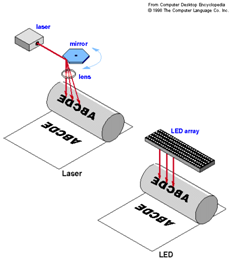LED – A look at printer technology
Printer Services Newsletter 3.7
In today’s world technology is changing at an ever increasing rate and this is no different for the humble printer. We are constantly asked by customers; what is the best printer to do the job in our office? Our job is to then filter through the vast array of choices available to help the customer to understand what they need to know so they can select the correct printer.
LED – A look at printer technology
The last time we looked at the cycle of how a laser printer creates a printed page from start to finish. Next we move forward in technology to the early 1990’s which saw the first LED printers. These printers are often still referred to as laser printers due to the similarities in the way they print.

As stated before, LED (light-emitting diode) works a lot like a conventional laser printer and uses a similar method of applying toner to the page. The biggest difference between the two technologies lies in the way the image is created on the drum unit. With a LED printer the laser unit is replaced with an array of LEDs to cover a strip of the drum from one end to the other. As a LED unit is smaller than a laser unit, these printers are more compact and more reliable due to the lack of moving parts. This lack of moving parts also means that the printer is quieter and uses less energy.
The ability to have a small bank of LEDs on each of the drum units in a colour machine also increases the speed at which they can create and print an image.
S-LED – Improving LED printers
The biggest down fall of LED technology is the lack of resolution due to limited amount of LEDs in an array. To be able to create higher quality images was the challenge which led to the creation of S-LED (self-scanning light emitting diode) printers. The technology breakthroughs in S-LED print heads came in the form of increased amounts of LEDS in the arrays, going from 2500 to over 10,000 LEDS, and a greatly improved driver chip which controls the array.
This driver chip is able to control each of the LEDs in the array as the machine prints by adjusting the pixels to output high resolution images. This adjustment also stops the problem the original LED printers had where the array would bow and skew.
So in conclusion, the addition of S-LED technology brings together the advantages of LED printers with the higher resolution output of laser printers creating excellent personal or small/home office printing solutions for the future.

WE HAVE SERVICED MELBOURNE
SINCE 1997 OVER 25 YEARS



